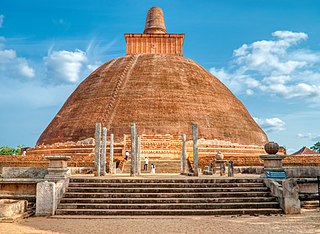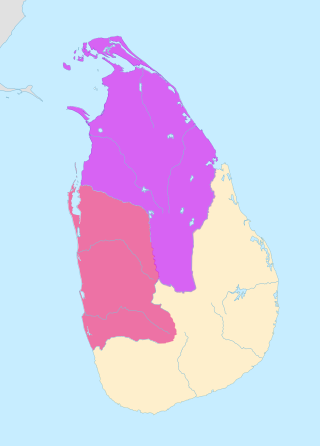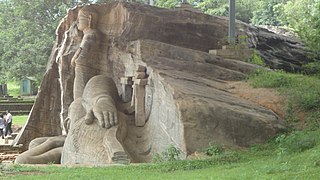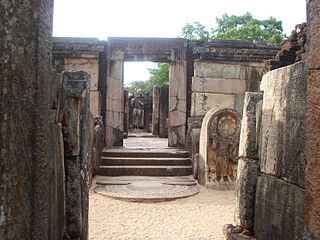
Mihintale is a mountain peak near Anuradhapura in Sri Lanka. It is believed by Sri Lankans to be the site of a meeting between the Buddhist monk Mahinda and King Devanampiyatissa which inaugurated the presence of Buddhism in Sri Lanka. It is now a pilgrimage site, and the site of several religious monuments and abandoned structures.

The Jetavanarama stupa or Jetavanaramaya is a stupa, or Buddhist reliquary monument, located in the ruins of Jetavana monastery in the UNESCO world heritage city of Anuradhapura, Sri Lanka. At 122 metres (400 ft), it was the world's tallest stupa, and the third tallest structure in the world when it was built by King Mahasena of Anuradhapura (273–301). He initiated the construction of the stupa following the destruction of the Mahaviharaya of Anuradhapura. His son Kithsirimevan completed the construction of the stupa, and it was renovated by Parakramabahu I of Polonnaruwa. A part of a belt tied by the Buddha is believed to be the relic that is enshrined here.

The Ruwanweli Maha Seya, also known as the Maha Thupa, is a stupa in Anuradhapura, Sri Lanka. Two quarts or one Dona of the Buddha's relics are enshrined in the stupa, making it the largest collection of his relics anywhere. It was built by Sinhalese King Dutugemunu in c. 140 B.C., who became king of Sri Lanka after a war in which the Chola King Elāra (Ellalan) was defeated. It is also known as Swarnamali Seya, Svaṇṇamāli Mahaceti and Rathnamali Seya.
Atamasthana or Eight sacred places are a series of locations in Sri Lanka where the Buddha had visited during his three visits to the country. The sacred places are known as Jaya Sri Maha Bodhiya, Ruwanwelisaya, Thuparamaya, Lovamahapaya, Abhayagiri Dagaba, Jetavanarama, Mirisaveti Stupa and Lankarama. They are situated in Anuradhapura, the capital of the ancient Anuradhapura Kingdom.

The architecture of ancient Sri Lanka displays a rich diversity, varying in form and architectural style from the Anuradhapura Kingdom through the Kingdom of Kandy (1469–1815). Sinhalese architecture also displays many ancient North Indian influences. Buddhism had a significant influence on Sri Lankan architecture after it was introduced to the island in the 3rd century BC, and ancient Sri Lankan architecture was mainly religious, with more than 25 styles of Buddhist monasteries. Significant buildings include the stupas of Jetavanaramaya and Ruwanvelisaya in the Anuradhapura kingdom and further in the Polonnaruwa kingdom. The palace of Sigiriya is considered a masterpiece of ancient architecture and ingenuity, and the fortress in Yapahuwa and the Temple of the tooth in Kandy are also notable for their architectural qualities. Ancient Sri Lankan architecture is also significant to sustainability, notably Sigiriya which was designed as an environmentally friendly structure.

Stupas, also called dagebas and cetiyas, are considered an outstanding type of architectural creation of ancient Sri Lanka. Under the influence of Buddhism, there were several changes in the field of architecture in Sri Lanka. The stupa commands a prominent place among these changes. The Stupa is also known by synonymous names such as Chaithya, Dagaba, Thupa, Seya and Vehera. Stupas designed and constructed in Sri Lanka are the largest brick structures known to the pre-modern world.
Yapahuwa was one of the ephemeral capitals of medieval Sri Lanka. The citadel of Yapahuwa lying midway between Kurunagala and Anuradhapura was built around a huge granite rock rising abruptly almost a hundred meters above the surrounding lowlands.

Parākramabāhu I, or Parakramabahu the Great, was the king of Polonnaruwa from 1153 to 1186. He oversaw the expansion and beautification of his capital, constructed extensive irrigation systems, reorganised the country's army, reformed Buddhist practices, encouraged the arts and undertook military campaigns in South India and Burma. The adage, "Not even a drop of water that comes from the rain must flow into the ocean without being made useful to man" is one of his most famous utterances."

The Kingdom of Polonnaruwa was the Sinhalese kingdom that expanded across the island of Sri Lanka and several overseas territories, from 1070 until 1232. The kingdom started expanding its overseas authority during the reign of Parakramabahu the Great.

The Gal Vihara, and known originally as the Uttararama, is a rock temple of the Buddha situated in the ancient city Polonnaruwa, the capital of the ancient Kingdom of Polonnaruwa, now present-day Polonnaruwa, in North Central Province, Sri Lanka. It was fashioned in the 12th century by King Parakramabahu I. The central feature of the temple is four rock relief statues of the Buddha, which have been carved into the face of a large granite gneiss rock. The images consist of a large seated figure, another smaller seated figure inside an artificial cavern, a standing figure, and a reclining figure. These are considered to be some of the best examples of ancient Sinhalese sculpting and carving arts, and have made the Gal Vihara the most visited monument at Polonnaruwa.

The Anuradhapura kingdom, named for its capital city, was the second established kingdom of ancient Sri Lanka. According to the Mahāvaṃsa, it was founded by King Pandukabhaya in 437 BC, whose authority extended throughout the country.

Sandakada Pahana, also known as Moonstone, is a unique feature of the architecture of ancient Sri Lanka. It is an elaborately carved semi-circular stone slab, usually placed at the bottom of staircases and entrances. First seen in the latter stage of the Anuradhapura period, the sandakada pahana evolved through the Polonnaruwa, Gampola and Kandyan period. According to historians, the sandakada pahana symbolises the cycle of Samsāra in Buddhism.

Sri Dalada Maligawa, commonly known in English as the Temple of the Sacred Tooth Relic, is a Buddhist temple in Kandy, Sri Lanka. It is located in the Royal Palace Complex of the former Kingdom of Kandy, which houses the relic of the tooth of the Buddha. Since ancient times, the relic has played an important role in local politics because it is believed that whoever holds the relic holds the governance of the country. The relic was historically held by Sinhalese kings. The temple of the tooth is a World Heritage Site mainly due to the temple and the relic.

A vaṭadāge is a type of Buddhist structure found in Sri Lanka. It also known as a dage, thupagara and a cetiyagara. Although it may have had some Indian influence, it is a structure that is more or less unique to the architecture of ancient Sri Lanka. Vatadages were built around small stupas for their protection, which often enshrined a relic or were built on hallowed ground. Circular in shape, they were commonly built of stone and brick and adorned with elaborate stone carvings. Vatadages may have also had a wooden roof, supported by a number of stone columns arranged in several concentric rows.

Rankoth Vehera is a stupa located in the ancient city of Polonnaruwa in Sri Lanka. The stupa was built by Nissanka Malla of Polonnaruwa, who ruled the country from 1187 to 1196. The Rankoth Vehera has been built according to the tradition of the stupas of the Anuradhapura Maha Viharaya and bears a close resemblance to Ruwanwelisaya. In fact, a stone inscription situated close to the stupa even identifies it by the name "Ruwanweli". However, it has later come to be known by the currently used name, Rankoth Vehera. In Sinhalese, ran means gold, kotha is the name given to the pinnacle of a stupa, and vehera means stupa or temple. Thus, the name Rankoth Vehera can be roughly translated to English as "Gold Pinnacled Stupa". Along with the Kiri Vehera, it is one of the most revered stupas in Polonnaruwa.

Nissanka Latha Mandapaya is a unique structure in the ancient city of Polonnaruwa in Sri Lanka. A màndapa is a pillared structure that is open on all sides and protects the person(s) inside from the sun with a roof. By definition, as of the 20th century, mándapas, as temporary structures, are built inside a house or a building and serve as recitation platform during remembrance ceremonies for the dead.

Hatadage is an ancient relic shrine in the city of Polonnaruwa, Sri Lanka. It was built by King Nissanka Malla, and had been used to keep the Relic of the tooth of the Buddha. The Hatadage had been built using stone, brick and wood, although only parts of the brick and stone walls now remain. It appears to have been a two-storey structure, but the upper storey has now been destroyed. Three Buddha statues carved out of granite rock are located within a chamber of the shrine.

Ridi Viharaya or Silver Temple is a 2nd-century BCE Theravada Buddhist temple in the village of Ridigama, Sri Lanka. Built during the reign of Dutthagamani of Anuradhapura, the temple is considered as the place where the silver ore, which provided silver to complete Ruwanwelisaya; one of the largest stupa in Sri Lanka, was discovered. According to the chronicles Mahavamsa and Thupavamsa, the Ridi Viharaya complex was built in gratitude for helping him cherish his dream of completing Ruwanwelisaya.

Muragala or muru gal, also known as a guardstone, are a unique feature of the Sinhalese architecture of ancient Sri Lanka. The muragala is a set of twin oblong slabs of stone, with a rounded top, located at the foot of the flight of steps, leading to a place of worship, situated on a higher elevation.

Korawakgala, or koravakgal (wingstones), are stone balustrades, which are located on either side of the stairs/steps leading to the entrance or door of a religious building or structure. They form one of three distinct architectural features at the entrance of most Buddhist structures in Sri Lanka, being the sandakada pahana (moonstone), muragala (guardstones) and the korawakgala (wingstones).




















